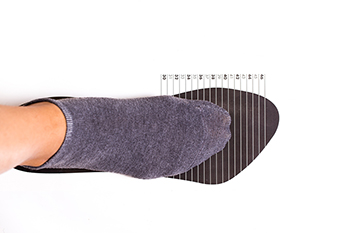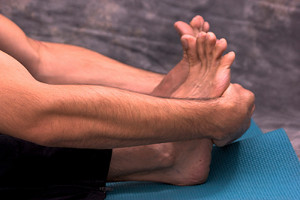February 2024
The Significance of Wearing Properly Fitted Shoes for Work

Selecting the right footwear for work is not merely a matter of style but also a critical aspect of occupational health and safety. Wearing properly fitted shoes can significantly impact overall comfort, productivity, and well-being throughout the workday. Ill-fitting shoes can lead to a myriad of problems, including blisters, corns, calluses, and ingrown toenails. Additionally, shoes that are too tight or narrow may cause foot pain, discomfort, and even contribute to the development of long-term foot conditions such as bunions or hammertoes. Conversely, shoes that are too loose can result in instability, increased risk of falls, and potential injury. Properly fitted shoes provide adequate support, cushioning, and alignment for the feet, helping to alleviate strain and pressure on the muscles and joints. Whether standing for extended periods or engaging in physical activities, wearing shoes that fit properly is essential for maintaining optimal foot health and minimizing the risk of workplace-related injuries. If you would like more information about choosing shoes that fit correctly for your work day, it is suggested that you confer with a podiatrist.
It is important to find shoes that fit you properly in order to avoid a variety of different foot problems. For more information about treatment, contact Dr. Robert Graser from Graser Podiatry and Bunion Surgery Institute. Our doctor will treat your foot and ankle needs.
Proper Shoe Fitting
Shoes have many different functions. They cushion our body weight, protect our feet, and allow us to safely play sports. You should always make sure that the shoes you wear fit you properly in order to avoid injuries and deformities such as: bunions, corns, calluses, hammertoes, plantar fasciitis, stress fractures, and more. It is important to note that although a certain pair of shoes might be a great fit for someone else, that doesn’t mean they will be a great fit for you. This is why you should always try on shoes before buying them to make sure they are worth the investment. Typically, shoes need to be replaced ever six months to one year of regular use.
Tips for Proper Shoe Fitting
- Select a shoe that is shaped like your foot
- Don’t buy shoes that fit too tight, expecting them to stretch to fit
- Make sure there is enough space (3/8” to ½”) for your longest toe at the end of each shoe when you are standing up
- Walk in the shoes to make sure they fit and feel right
- Don’t select shoes by the size marked inside the shoe, but by how the shoe fits your foot
The shoes you buy should always feel as good as they look. Shoes that fit properly will last longer, feel better, and improve your way of life each day.
If you have any questions, please feel free to contact our office located in Boerne, . We offer the newest diagnostic and treatment technologies for all your foot care needs.
Common Causes of Foot Stress Fractures

Stress fractures are hairline fractures in the foot that are caused by repetitive activity, such as running on hard surfaces. These tiny cracks, that can affect various foot bones, often cause pain and further complications if left untreated. Calcaneal stress fractures affect the heel bone, and are common among soldiers and runners. Symptoms include gradual heel pain worsened by weight-bearing activities. Calcaneal stress fractures often require bone scans or an MRI for diagnosis. Navicular stress fractures are more prevalent in sprinters and jumpers. They cause a midfoot ache that worsens with exercise and is accompanied by tenderness over the navicular bone. Metatarsal stress fractures, particularly in the second metatarsal, arise from overuse and poor biomechanics. Symptoms include gradual foot pain and swelling but they are difficult to identify, necessitating advanced imaging for diagnosis. Jones fractures, occurring in the fifth metatarsal after sudden trauma or ankle twisting, cause acute pain, tenderness, and weight-bearing difficulty. If you have foot pain that may be caused by repetitive activities, it is suggested that you schedule an appointment with a podiatrist who can conduct a thorough examination and suggest correct treatment options.
Stress fractures occur when there is a tiny crack within a bone. To learn more, contact Dr. Robert Graser from Graser Podiatry and Bunion Surgery Institute. Our doctor can provide the care you need to keep you pain free and on your feet.
How Are They Caused?
Stress fractures are the result of repetitive force being placed on the bone. Since the lower leg and feet often carry most of the body’s weight, stress fractures are likely to occur in these areas. If you rush into a new exercise, you are more likely to develop a stress fracture since you are starting too much, too soon. Pain resulting from stress fractures may go unnoticed at first, however it may start to worsen over time.
Risk Factors
- Gender – They are more commonly found in women compared to men.
- Foot Problems – People with unusual arches in their feet are more likely to develop stress fractures.
- Certain Sports – Dancers, gymnasts, tennis players, runners, and basketball players are more likely to develop stress fractures.
- Lack of Nutrients – A lack of vitamin D and calcium may weaken the bones and make you more prone to stress fractures
- Weak Bones – Osteoporosis can weaken the bones therefore resulting in stress fractures
Stress fractures do not always heal properly, so it is important that you seek help from a podiatrist if you suspect you may have one. Ignoring your stress fracture may cause it to worsen, and you may develop chronic pain as well as additional fractures.
If you have any questions, please feel free to contact our office located in Boerne, . We offer the newest diagnostic and treatment technologies for all your foot care needs.
How Pregnancy Affects Foot Structure

Pregnancy brings about numerous changes in a woman's body, and one area that often transforms is the feet. As the body prepares for childbirth, hormonal fluctuations, particularly the hormone relaxin, contribute to increased flexibility in ligaments and tendons. This heightened flexibility can lead to changes in the arch of the foot, causing it to flatten or develop a more pronounced arch, depending on the individual. Additionally, the added weight and pressure on the feet can result in swelling and a potential increase in shoe size. These changes are not uniform, and each woman may experience variations in foot structure during pregnancy. As a result, expectant mothers need to prioritize comfortable footwear, adequate support, and regular foot care to alleviate any discomfort. If you have foot pain during your pregnancy or would like additional information on how your foot structure may change, it is suggested that you consult a podiatrist.
Pregnant women with swollen feet can be treated with a variety of different methods that are readily available. For more information about other cures for swollen feet during pregnancy, consult with Dr. Robert Graser from Graser Podiatry and Bunion Surgery Institute. Our doctor will attend to all of your foot and ankle needs.
What Foot Problems Can Arise During Pregnancy?
One problem that can occur is overpronation, which occurs when the arch of the foot flattens and tends to roll inward. This can cause pain and discomfort in your heels while you’re walking or even just standing up, trying to support your baby.
Another problem is edema, or swelling in the extremities. This often affects the feet during pregnancy but tends to occur in the later stages.
How Can I Keep My Feet Healthy During Pregnancy?
- Wearing orthotics can provide extra support for the feet and help distribute weight evenly
- Minimize the amount of time spent walking barefoot
- Wear shoes with good arch support
- Wear shoes that allow for good circulation to the feet
- Elevate feet if you experience swelling
- Massage your feet
- Get regular, light exercise, such as walking, to promote blood circulation to the feet
If you have any questions please feel free to contact our office located in Boerne, . We offer the newest diagnostic and treatment technologies for all your foot and ankle needs.
Foot and Toe Stretching for General Well-Being

In the quest for overall health and vitality, the incredible benefits that come from incorporating foot and toe stretching into our daily routine is often overlooked. Stretching not only improves flexibility but also plays a vital role in enhancing the strength and mobility of the feet. These simple yet effective exercises promote better blood circulation, alleviating tension and reducing the risk of common foot issues. Regular stretching can contribute to improved posture, balance, and stability, benefiting not only the feet but the entire musculoskeletal system. Additionally, toe stretching exercises can prevent and alleviate discomfort associated with conditions like plantar fasciitis and toe deformities. Embracing a consistent routine of gentle stretches not only revitalizes tired feet but also fosters a sense of relaxation and well-being. If you are interested in learning about what type of foot and toe stretches to perform, it is suggested that you consult a podiatrist.
Stretching the feet is a great way to prevent injuries. If you have any concerns with your feet consult with Dr. Robert Graser from Graser Podiatry and Bunion Surgery Institute. Our doctor will assess your condition and provide you with quality foot and ankle treatment.
Stretching the Feet
Being the backbone of the body, the feet carry your entire weight and can easily become overexerted, causing cramps and pain. As with any body part, stretching your feet can serve many benefits. From increasing flexibility to even providing some pain relief, be sure to give your feet a stretch from time to time. This is especially important for athletes or anyone performing aerobic exercises, but anyone experiencing foot pain or is on their feet constantly should also engage in this practice.
Great ways to stretch your feet:
- Crossing one leg over the others and carefully pull your toes back. Do 10-20 repetitions and repeat the process for each foot
- Face a wall with your arms out and hands flat against the wall. Step back with one foot and keep it flat on the floor while moving the other leg forward. Lean towards the wall until you feel a stretch. Hold for 30 seconds and perform 10 repetitions for each foot
- Be sure not to overextend or push your limbs too hard or you could risk pulling or straining your muscle
Individuals who tend to their feet by regular stretching every day should be able to minimize foot pain and prevent new problems from arising.
If you have any questions, please feel free to contact our office located in Boerne, . We offer the newest diagnostic and treatment technologies for all your foot care needs.
Blog Archives
- July 2024
- June 2024
- May 2024
- April 2024
- March 2024
- February 2024
- January 2024
- December 2023
- November 2023
- October 2023
- September 2023
- August 2023
- July 2023
- June 2023
- May 2023
- April 2023
- March 2023
- February 2023
- January 2023
- December 2022
- November 2022
- October 2022
- September 2022
- August 2022
- July 2022
- June 2022
- May 2022
- April 2022
- March 2022
- February 2022
- January 2022
- December 2021
- November 2021
- October 2021
- September 2021
- August 2021
- July 2021
- June 2021
- May 2021
- April 2021
- March 2021
- February 2021
- January 2021
- December 2020
- November 2020
- October 2020
- September 2020
- August 2020
- July 2020
- June 2020
- May 2020
- April 2020
- March 2020
- February 2020
- January 2020
- December 2019
- November 2019
- October 2019
- September 2019
- August 2019
- July 2019
- June 2019
- May 2019
- April 2019
- March 2019
- February 2019
- January 2019
- December 2018
- November 2018
- October 2018
- September 2018
- August 2018
- July 2018
- June 2018
- May 2018









